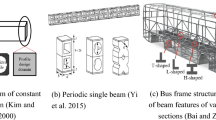Abstract
Structural optimization methods have been developed over the past three decades for minimizing the weight or the cost of the structure subjected to design constraints. As the size of the structure increases, however, the computational time becomes prohibitively high. With the recent availability of supercomputers, optimization of very large and complex structures is achievable. This paper is about impact of vectorization on large scale structural optimization. A judiciously vectorized structural optimization algorithm is presented using the optimality criteria approach. The algorithm has been applied to minimum weight design of three highrise and super highrise buildings (mega strutures) ranging in height from 50 stories to 161 stories and in size from 848 to 6136 members. The performance of the vectorized algorithm is discussed in terms of MFLOPS and CPU time. It is concluded that significant speedup can be achieved through the adroit use of the vectorization techniques.
Similar content being viewed by others
References
Adeli, H; Kamal, O. 1986: Efficient optimization of space trusses.Comp. & Struct. 24, 501–511
Adeli, H.; Kamal, O. 1992a: Concurrent optimization of large structures. Part I — algorithm.J. Aerospace Engineering, ASCE 5, 79–90
Adeli, H.; Kamal, O. 1992b: Concurrent optimization of large structures. Part II — applications.J. Aerospace Engineering, ASCE 5, 91–110
Adeli, H.; Vishnubhotla, P. 1992: Parallel machines. In: Adeli, H. (ed.)Parallel processing in computational mechanics, pp. 1–20. New York: Marcel Dekker
Adeli, H. (ed.) 1994:Advances in design optimization. London: Chapman and Hall (in press)
Arora, J.S. 1989:Introduction to optimum design. New York: McGraw Hill
Cray 1990:CF77 compiling system. Volume 1. Mendota Heights: Cray Research Inc.
Cray 1990:CF77 compiling system. Volume 2. Mendota Heights: Cray Research Inc.
Cray 1990:CF77 compiling system. Volume 4. Mendota Heights: Cray Research Inc.
Hsu, H.L; Adeli, H. 1991: A microtasking algorithm for optimization of structures.Int. J. Supercomputer Appl. 5, 81–90
Khot, N.S.; Berke, L. 1987: Structural optimization using optimality criteria methods. In: Atrek, E.; Gallagher, R.H.; Ragsdell, K.M.; Zienkiewicz, O.C. (eds.)New directions in optimum structural design, pp. 47–74. New York: John Wiley
Venkayya, V.B. 1971: Design of optimum structures.Comp. & Struct. 1, 265–309
Zima, H.; Chapman, B. 1991:Supercompilers for parallel and vector computers. New York: ACM Press
Author information
Authors and Affiliations
Rights and permissions
About this article
Cite this article
Soegiarso, R., Adeli, H. Impact of vectorization on large-scale structural optimization. Structural Optimization 7, 117–125 (1994). https://doi.org/10.1007/BF01742517
Received:
Issue Date:
DOI: https://doi.org/10.1007/BF01742517




